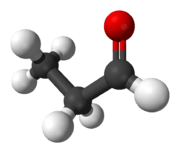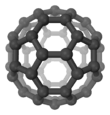Propionaldehyde
Propionaldehyde or propanal is the organic compound with the formula CH3CH2CHO. It is a saturated 3-carbon aldehyde and is a structural isomer of acetone. It is a colourless, flammable liquid with a slightly irritating, fruity odour.
| |||
 | |||
 | |||
| Names | |||
|---|---|---|---|
| IUPAC name
Propanal | |||
| Systematic IUPAC name
Propanal | |||
Other names
| |||
| Identifiers | |||
CAS Number |
|||
3D model (JSmol) |
|||
| 3DMet | |||
| ChEBI | |||
| ChEMBL | |||
| ChemSpider | |||
| ECHA InfoCard | 100.004.204 | ||
| EC Number |
| ||
| KEGG | |||
PubChem CID |
|||
| RTECS number |
| ||
| UNII | |||
| UN number | 1275 | ||
CompTox Dashboard (EPA) |
|||
InChI
| |||
SMILES
| |||
| Properties | |||
Chemical formula |
C3H6O | ||
| Molar mass | 58.080 g·mol−1 | ||
| Appearance | Colourless liquid | ||
| Odor | Pungent, fruity | ||
| Density | 0.81 g cm−3 | ||
| Melting point | −81 °C (−114 °F; 192 K) | ||
| Boiling point | 46 to 50 °C (115 to 122 °F; 319 to 323 K) | ||
Solubility in water |
20 g/100 mL | ||
Magnetic susceptibility (χ) |
-34.32·10−6 cm3/mol | ||
| Viscosity | 0.6 cP at 20 °C | ||
| Structure | |||
Molecular shape |
C1, O: sp2
C2, C3: sp3 | ||
Dipole moment |
2.52 D | ||
| Hazards | |||
| GHS pictograms |    | ||
| GHS Signal word | Danger | ||
GHS hazard statements |
H225, H302, H332, H315, H318, H335[1] | ||
GHS precautionary statements |
P210, P261, P280, P304+340+312, P305+351+338, P310, P403+235[1] | ||
| NFPA 704 (fire diamond) | 
3
2
2 | ||
| Flash point | −26 °C (−15 °F; 247 K) | ||
Autoignition temperature |
175 °C (347 °F; 448 K) | ||
| Related compounds | |||
Related aldehydes |
Acetaldehyde Butyraldehyde | ||
Except where otherwise noted, data are given for materials in their standard state (at 25 °C [77 °F], 100 kPa). | |||
| Infobox references | |||
Production
Propionaldehyde is mainly produced industrially through hydroformylation, by combining synthesis gas (carbon monoxide and hydrogen) with ethylene using a metal (typically rhodium) catalyst:
- CO + H2 + C2H4 → CH3CH2CHO
In this way, several hundred thousand tons are produced annually.[2]
Laboratory preparation
Propionaldehyde may also be prepared by oxidizing 1-propanol with a mixture of sulfuric acid and potassium dichromate. The reflux condenser contains water heated at 60 °C, which condenses unreacted propanol, but allows propionaldehyde to pass. The propionaldehyde vapor is immediately condensed into a suitable receiver. In this arrangement, any propionaldehyde formed is immediately removed from the reactor, thus it does not get over-oxidized to propionic acid.[3]
Uses
It is principally used as a precursor to trimethylolethane (CH3C(CH2OH)3) through a condensation reaction with formaldehyde; this triol is an important intermediate in the production of alkyd resins. It is used in the synthesis of several common aroma compounds (cyclamen aldehyde, helional, lilial). Other applications include reduction to propanol and oxidation to propionic acid.[2]
Condensation of propionaldehyde with tert-butylamine gives CH3CH2CH=N-t-Bu, a three-carbon building block used in organic synthesis. Deprotonation of this imine with LDA produces CH3CHLiCH=N-t-Bu, which in turn condenses with aldehydes.[4]
Extraterrestrial occurrence
Astronomers have detected propionaldehyde (along with acrolein) in the molecular cloud Sagittarius B2 near the center of the Milky Way Galaxy, about 26,000 light years from Earth.[5][6][7]
On 30 July 2015, scientists reported that upon the first touchdown of the Philae lander on comet 67/P's surface, measurements by the COSAC and Ptolemy instruments revealed sixteen organic compounds, four of which were seen for the first time on a comet, including acetamide, acetone, methyl isocyanate and propionaldehyde.[8][9][10]
References
- Record of Propanal in the GESTIS Substance Database of the Institute for Occupational Safety and Health, accessed on 22 March 2020.
- Anthony J. Papa "Propanal" In Ullmann's Encyclopedia of Industrial Chemistry, 2011, WIley-VCH, Weinheim. doi:10.1002/14356007.a22_157.pub2
- Charles D. Hurd and R. N. Meinert (1943). "Propionaldehyde". Organic Syntheses.; Collective Volume, 2, p. 541
- Peralta, M. M. "Propionaldehyde t-Butylimine" in Encyclopedia of Reagents for Organic Synthesis (Ed: L. Paquette) 2004, J. Wiley & Sons, New York. doi:10.1002/047084289.
- Scientists Discover Two New Interstellar Molecules: Point to Probable Pathways for Chemical Evolution in Space, National Radio Astronomy Observatory, June 21, 2004
- Two newly found space molecules. By: Goho, Alexandra, Science News, 00368423, 7/24/2004, Vol. 166, Issue 4
- Chemical Precursors to Life Found in Space Scientists say that a universal prebiotic chemistry may be at work
- Jordans, Frank (30 July 2015). "Philae probe finds evidence that comets can be cosmic labs". The Washington Post. Associated Press. Retrieved 30 July 2015.
- "Science on the Surface of a Comet". European Space Agency. 30 July 2015. Retrieved 30 July 2015.
- Bibring, J.-P.; Taylor, M.G.G.T.; Alexander, C.; Auster, U.; Biele, J.; Finzi, A. Ercoli; Goesmann, F.; Klingehoefer, G.; Kofman, W.; Mottola, S.; Seidenstiker, K.J.; Spohn, T.; Wright, I. (31 July 2015). "Philae's First Days on the Comet - Introduction to Special Issue". Science. 349 (6247): 493. Bibcode:2015Sci...349..493B. doi:10.1126/science.aac5116. PMID 26228139.
| Wikimedia Commons has media related to Propionaldehyde. |


